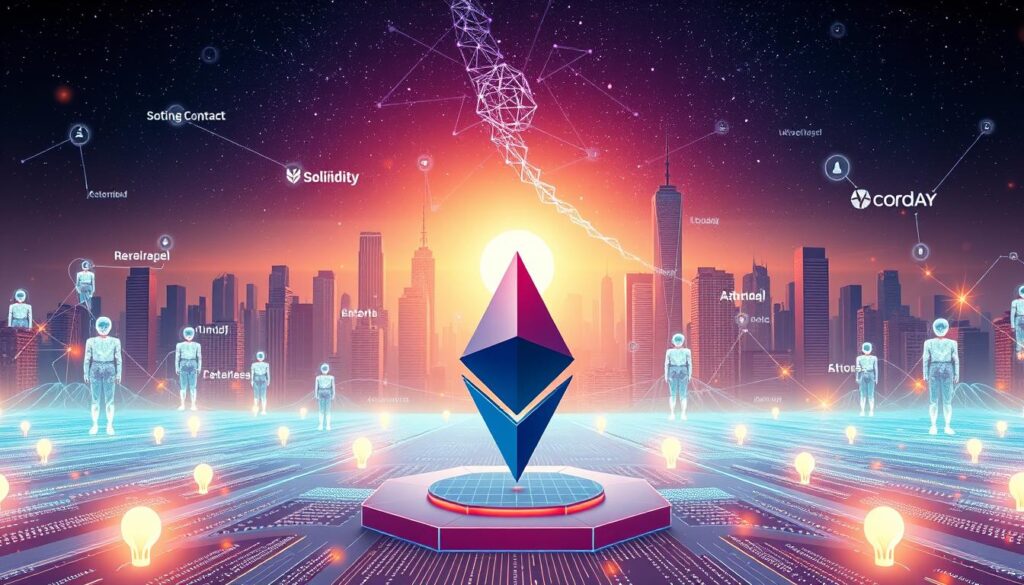Now Reading: Automate with Smart Contract Blockchain Automation Platform
- 01
Automate with Smart Contract Blockchain Automation Platform
Automate with Smart Contract Blockchain Automation Platform

Digital agreements are changing how companies operate today. Self-executing contracts on distributed ledgers create new opportunities for efficiency. The market for this technology shows incredible growth potential.
Industry projections reveal a massive expansion ahead. The sector was valued at $2.2 billion in 2024. Experts predict it will reach $29.2 billion by 2035. This represents a 26.5% annual growth rate.
These systems enable secure, transparent execution of predefined conditions. They operate without traditional intermediaries. This approach reduces delays and minimizes costs significantly.
Businesses across finance, supply chain, and other sectors benefit from enhanced security. The technology supports tamper-proof agreement management. Companies can choose solutions that match their specific needs.
Some options prioritize speed and affordability. Others focus on privacy and security features. Understanding these differences helps organizations make informed decisions.
Key Takeaways
- Digital agreement systems are transforming business operations across multiple industries
- The market for this technology is experiencing rapid growth with significant expansion projected
- These solutions eliminate middlemen, reducing delays and operational expenses
- Different systems cater to various business priorities like speed, cost, or security
- Secure, transparent execution of predefined conditions is a core benefit
- Companies should evaluate options based on their specific operational requirements
- The technology supports applications from finance to supply chain management
Introduction: Blockchain Automation & Smart Contracts
Distributed ledger systems provide the foundation for next-generation automated business processes. These technologies create immutable records shared across network participants. The infrastructure enables transparent and secure operations.
Overview of Blockchain Technology
A distributed ledger requires specific extensions to function as a programmable agreement system. Developers add tools for secure code storage and autonomous execution. These additions ensure transparent and deterministic operations.
Bitcoin pioneered the first digital, tamper-proof agreements with limited scope. The major breakthrough came with Ethereum’s introduction of programmable functionality. The Ethereum Virtual Machine (EVM) manages system state and enables advanced capabilities.
Role of Automation in Modern Business
Automated systems transform critical business processes like payments and compliance verification. They eliminate manual approvals and reduce human errors. This approach streamlines operations across multiple industries.
Businesses achieve faster transaction processing without centralized intermediaries. The decentralized nature creates trustless environments for secure interactions. Companies can explore various development options to match their specific needs.
These technological capabilities support applications in finance, supply chain, and healthcare. The combination of distributed systems and automated execution provides significant advantages. Organizations benefit from reduced administrative overhead and enhanced security.
What Are Smart Contracts and How Do They Work?
Self-executing digital protocols are revolutionizing contractual relationships across industries. These innovative tools represent a new approach to business agreements.
Definition and Execution Process
Digital agreements function as automated programs that execute when specific terms are satisfied. They operate on a simple “if/when-then” principle.
The execution process follows six key steps. First, parties identify collaboration opportunities and expected outcomes. Second, they establish triggering conditions like payment approvals.
Developers then encode the business logic into computer programs. Encryption ensures secure authentication between entities. When consensus is reached, the code executes automatically.
Finally, all network participants update their records simultaneously. This creates an immutable ledger of the transaction.
Benefits over Traditional Contracts
These digital protocols offer significant advantages compared to paper-based agreements. The automated nature eliminates manual processing delays.
Transactions occur immediately when predetermined conditions are met. This speed transforms business operations across multiple sectors.
| Feature | Digital Agreements | Traditional Contracts |
|---|---|---|
| Execution Speed | Immediate upon condition fulfillment | Days or weeks for processing |
| Cost Structure | Eliminates intermediary fees | Includes legal and administrative costs |
| Security Level | Encrypted, tamper-proof records | Vulnerable to human error and alteration |
| Transparency | Shared among all participants | Limited visibility between parties |
The enhanced security comes from cryptographic protection. Records become extremely difficult to alter or hack. This builds trust without third-party involvement.
Cost savings are substantial by removing intermediaries. Businesses achieve greater efficiency and accuracy in their operations.
The Rise of Blockchain in Business Automation
Business automation through cryptographic ledgers has undergone significant transformation since its inception. The evolution from basic digital protocols to sophisticated systems represents a remarkable technological journey.
Milestones in Blockchain Evolution
Ethereum’s arrival between 2013 and 2015 marked a pivotal moment. This network introduced flexible self-executing agreements that revolutionized the landscape.
The platform’s Solidity programming language proved revolutionary. Based on JavaScript, it gave front-end developers immediate access to create sophisticated digital agreements.
Ethereum’s Virtual Machine became the industry standard computation engine. Many subsequent systems adopted EVM compatibility to leverage the growing developer ecosystem.
Early limitations soon became apparent. The network processed only dozens of transactions per second compared to Visa’s 24,000. This scalability challenge drove innovation in second-generation solutions.
The industry responded with Layer 1 and Layer 2 architectures. L1 systems execute agreements directly on their core network. L2 solutions process transactions in parallel spaces for greater efficiency.
Continuous innovation addresses scaling challenges as networks compete for Web 3.0 dominance. Each generation learns from predecessors, introducing improvements in speed and security.
Key Features of the Smart Contract Blockchain Automation Platform
The technological backbone for these autonomous agreements comes in several distinct forms, each with unique strengths. Understanding these categories helps businesses select the right fit.

Core Capabilities and Integrations
These systems provide essential tools for secure operations. Code is stored in a tamper-proof manner, ensuring integrity.
Execution is decentralized and follows predefined rules exactly. Network consensus verifies every action before permanent recording.
Modern solutions offer robust integration features. They connect with existing enterprise software through APIs and SDKs. This supports interoperability across different networks and programming languages.
Advantages for Enterprises
Companies gain significant operational benefits. Automated execution slashes processing times and reduces human error.
Substantial cost reduction is achieved by removing intermediaries. Enhanced security comes from cryptographic protection and distributed verification.
All participants enjoy full transparency into verified transactions. This builds trust in multi-party dealings.
| Platform Category | Primary Focus | Ideal Use Case |
|---|---|---|
| Large Public Ecosystems | Broad functionality & developer community | Applications requiring maximum decentralization |
| Optimized Networks | Speed and cost-efficiency | High-volume, low-cost transactions |
| Private Frameworks | Permissioned control & compliance | Enterprise consortia and regulated industries |
| Specialized Management Tools | Cross-partner agreement lifecycle | Streamlining operations between trusted partners |
The modular nature of these architectures allows for customization. Businesses can prioritize speed, privacy, or compliance based on their specific needs.
Top Smart Contract Platforms for Business Process Automation
Companies today face critical decisions when selecting digital agreement execution environments. The market offers diverse solutions catering to different business needs and technical requirements.
Ethereum and Second-Generation Platforms
Ethereum maintains dominance with the largest developer community and market capitalization. Its extensive ecosystem allows applications to scale rapidly within a massive virtual economy.
Second-generation solutions address earlier limitations. BNB Smart Chain supports millions of daily users with low transaction costs. Solana achieves remarkable throughput of approximately 65,000 transactions per second.
Cardano emerged as an energy-efficient alternative with Plutus functionality. Avalanche offers innovative three-chain architecture processing 4,500 TPS. These platforms provide enhanced performance while maintaining security.
Private vs Public Smart Contract Solutions
Public networks like Ethereum and Solana offer open access and large user bases. Private solutions like Hyperledger Fabric provide fine-grained data control for authorized participants.
Corda specializes in legally enforceable transactions with confidential channels. Businesses choose based on priorities: public networks offer token incentives, while private systems ensure regulatory compliance.
Market Trends and Adoption Rates
The sector shows explosive growth potential, projected to reach $29.2 billion by 2035. Major corporations including JP Morgan and Walmart utilize Ethereum for various applications.
Over 44 million digital agreements have deployed on Ethereum since 2015. Solana hosts more than 500 DApps, while Avalanche supports over 150 projects. This widespread adoption indicates accelerating mainstream acceptance.
Comparative Analysis: Scalability, Performance, and Efficiency
When selecting execution environments, businesses must carefully weigh transaction throughput against other critical factors. Different systems offer varying capabilities that impact operational effectiveness.
Performance Metrics Compared
Transaction processing speeds vary dramatically across different networks. Ethereum handles approximately 30 transactions per second using Proof of Stake consensus. Solana achieves remarkable throughput of around 65,000 TPS with innovative Proof of History technology.

Avalanche processes 4,500 TPS with minimal fees, while Algorand reaches 6,000 transactions. Enterprise solutions like Hyperledger Fabric achieve 20,000 TPS with zero transaction costs. These differences significantly impact real-world applications.
Scalability considerations extend beyond raw speed. Finality time and network reliability matter for business operations. Some systems prioritize security over maximum performance, creating important tradeoffs.
Efficiency metrics include energy consumption and developer tooling. Proof of Stake systems generally offer better energy efficiency than older mechanisms. According to recent research findings, proper platform selection depends on specific use case requirements.
Enhancing Security and Trust in Blockchain Transactions
Digital trust mechanisms form the bedrock of secure decentralized systems. These frameworks ensure transactional integrity through advanced cryptographic methods.
Every recorded action becomes permanently linked within an immutable chain. This structure makes unauthorized alterations virtually impossible without network consensus.
Security Protocols and Best Practices
Self-executing agreements provide tamper-proof execution through cryptographic linking. Each entry connects to previous and subsequent records in the chain.
Encryption techniques enable secure authentication between participating entities. These protocols protect sensitive data during message transfers and verification processes.
Formal verification methods mathematically prove code correctness before deployment. Platforms like Tezos implement these rigorous validation techniques.
Thorough auditing and comprehensive testing across scenarios identify potential vulnerabilities. Continuous monitoring detects anomalous behavior after implementation.
Managing Risk and Compliance
Real-world incidents demonstrate the importance of robust security measures. The DAO incident resulted from exploited vulnerabilities in code logic.
Risk management strategies include multi-signature requirements for high-value actions. Upgrade mechanisms allow for fixing discovered issues post-deployment.
Compliance considerations address regulatory requirements through fine-grained data controls. Systems like Hyperledger Fabric ensure only authorized personnel access specific information.
Transparent verification processes build confidence among all participants. Consensus mechanisms require majority agreement before recording state changes.
These approaches create immutable audit trails for compliance and dispute resolution. Different consensus methods provide varying protection levels against attack vectors.
Cost Savings and Operational Benefits of Automation
One of the most compelling arguments for digital agreements is the direct and measurable reduction in operational expenditures. Businesses achieve significant financial advantages by automating transaction processes.
Financial Advantages in Transaction Automation
Substantial savings begin with the elimination of third-party intermediaries. This removes fees typically ranging from 3% to 10% per transaction.
Direct transaction costs vary dramatically across different systems. Choosing the right environment is crucial for maximizing efficiency.
| System | Transaction Fee | Primary Advantage |
|---|---|---|
| Hyperledger Fabric | $0.00 | Zero cost for permissioned networks |
| Avalanche | ~$0.000000583 | Extremely low fees for high volume |
| Solana | ~$0.00025 | Very low cost with high speed |
| Algorand | ~$0.00021 | Low fees and fast finality |
Beyond direct fees, automation reduces labor costs associated with manual approvals. It also minimizes expenses from human errors that require correction.
Faster settlement times decrease working capital requirements. This creates compounding savings through accelerated business cycles.
Transparent, automatically-executed agreements remove reconciliation and dispute resolution costs. The result is a leaner, more efficient operational model.
Use Cases Across Supply Chain, Finance, and Healthcare
From retail logistics to medical records management, digital protocols are reshaping traditional business models. These applications demonstrate practical value across multiple industries.
Streamlining Supply Chain Operations
Major retailers like Walmart use specialized systems for product tracking. Their supply chain benefits from transparent custody records.
Goods move from origin to shelf with automatic verification. This prevents counterfeit products and ensures quality standards.
Delivery confirmation triggers immediate supplier payments. The entire supply network gains complete visibility.
Impact on Finance and Healthcare
Financial applications include decentralized finance (DeFi) platforms. These handle trading and lending without intermediaries.
Healthcare systems manage insurance claims and patient data securely. Medical supply chain verification prevents drug counterfeiting.
These real-world use cases show how different industries benefit. Each sector adapts the technology to specific needs.
Developer Ecosystem, Adoption, and Community Support
The strength of a technology’s developer ecosystem often determines its long-term success and viability. A vibrant community provides extensive resources and faster problem resolution.
Community and Developer Resources
Ethereum boasts the largest developer community with tens of thousands of active contributors. This mature ecosystem offers comprehensive documentation and extensive tutorials.
Programming language support varies significantly across different systems. Ethereum’s Solidity language, based on JavaScript syntax, made development accessible to millions of web developers.

Other systems support multiple languages including Go, Java, and Swift. This flexibility attracts diverse developer backgrounds and skill sets.
Development tools significantly impact project velocity. Established platforms offer mature tooling and extensive support networks.
Community support mechanisms include active forums and GitHub repositories. Hackathons and developer grants incentivize ecosystem growth.
Adoption indicators reveal community strength through deployed applications and enterprise partnerships. These metrics help businesses assess platform viability.
Navigating the Future of Blockchain Innovation
The projected market growth from USD 2.2 billion in 2024 to USD 29.2 billion by 2035 signals a period of intense innovation ahead. This expansion is driven by emerging trends that address current limitations and unlock new possibilities.
Emerging Trends and Technologies
Scalability remains a primary focus. Layer 2 solutions like ZK-Rollups and Optimistic Rollups process transactions off the main chain for greater efficiency.
Cross-chain technology is another major trend. Systems like Polkadot and Cosmos enable different networks to communicate seamlessly.
Artificial intelligence is also integrating with distributed ledgers. For instance, Casper’s partnership with IBM Consulting uses AI to improve auditability.
Innovation in Decentralized Applications
The evolution of legal agreements is a key area. Companies like DocuSign are bridging traditional contracts with executable digital versions using AI.
This paves the way for more sophisticated DApps in the Web3 space. These decentralized applications will benefit from enhanced privacy features and specialized consensus mechanisms.
| Innovation Area | Key Technology | Primary Benefit |
|---|---|---|
| Scaling Solutions | ZK-Rollups | High throughput with security |
| Interoperability | Cross-Chain Protocols | Seamless network communication |
| AI Integration | Automated Auditing | Improved compliance and security |
| Legal Tech | Smart Legal Contracts | Business-user accessible tools |
These advancements collectively shape the future landscape, making blockchain technology more accessible and powerful for various platforms and applications.
Expert Tips for Selecting the Perfect Smart Contract Platform
The decision process for choosing execution frameworks demands thorough analysis of operational requirements and technical capabilities. Each option presents unique trade-offs that impact long-term success.
Key Considerations for Your Business
Business leaders should evaluate several critical factors during the selection process. Scalability determines whether a system can handle projected transaction volumes efficiently.
Security track records reveal how well platforms withstand attacks and vulnerabilities. The strength of developer communities accelerates project development through available resources.
| Evaluation Factor | High Priority For | Key Questions |
|---|---|---|
| Transaction Speed | Trading applications, gaming | Can it process thousands of transactions per second? |
| Security History | Financial services, DeFi | Has it been battle-tested over several years? |
| Cost Structure | Startups, high-volume use | Are transaction fees predictable and affordable? |
| Ecosystem Size | All businesses | Is there strong community support and documentation? |

Expert Advice and Industry Insights
Industry experts recommend defining specific business requirements before comparing options. Create a weighted scoring matrix to objectively evaluate different platforms.
Financial services prioritize security and regulatory compliance. Supply chain applications often focus on privacy and permissioned access. Gaming businesses typically emphasize speed and low transaction costs.
Conduct proof-of-concept testing on shortlisted systems. Consult with existing users before making final decisions. This approach ensures alignment with organizational goals.
Conclusion
Modern enterprises face a critical juncture where digital execution frameworks redefine traditional business models. The projected growth from $2.2 billion to $29.2 billion by 2035 demonstrates this technology’s essential role in competitive business strategies.
These solutions deliver transformative benefits including cost reduction through intermediary elimination and enhanced security via cryptographic protection. The automation of manual processes creates unprecedented efficiency gains while built-in transparency builds trust between parties.
No single system serves all needs equally. Selection depends on specific requirements whether prioritizing speed, cost efficiency, or regulatory compliance. Businesses must evaluate scalability, security history, and community support when choosing their approach.
The future promises continued innovation with Layer 2 scaling and cross-chain interoperability expanding applications. Companies should begin exploring these platforms through pilot projects to build expertise and avoid competitive disadvantages.
This represents a fundamental shift in how digital agreements are executed. Smart contracts and blockchain technology offer businesses new ways to streamline operations across the industry landscape.
FAQ
How does a smart contract platform improve business efficiency?
These systems streamline complex processes by automatically executing agreements when preset conditions are met. This removes manual oversight, reduces errors, and accelerates transaction speed, leading to significant gains in operational efficiency.
What industries benefit most from this technology?
Supply chain, finance, and healthcare see major advantages. In supply chain, it enhances transparency and traceability. For finance, it automates settlements and payments. In healthcare, it securely manages patient data and consent.
Are private or public blockchain networks better for enterprises?
The choice depends on specific needs. Private networks offer greater control and privacy, ideal for internal processes. Public networks, like Ethereum, provide higher decentralization and transparency, often preferred for applications involving external users.
What are the primary security benefits of using this automation?
The technology offers robust security through cryptographic principles and consensus mechanisms. Once deployed, the code is tamper-proof, ensuring that agreements execute exactly as written, which builds immense trust among all parties.
How do these platforms handle scalability for high-volume transactions?
Modern solutions address scalability with innovations like layer-2 protocols and alternative consensus models, such as proof-of-stake. These advancements increase processing speed and reduce costs, making the technology viable for large-scale business applications.
What should a business consider before adopting a smart contract platform?
Key considerations include the specific use case, required transaction speed, integration capabilities with existing systems, development community support, and the total cost of implementation, including gas fees on some networks.














